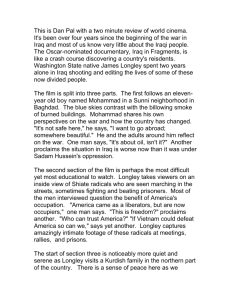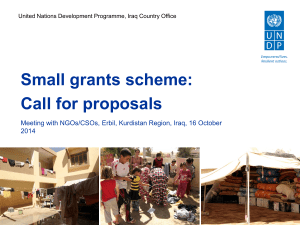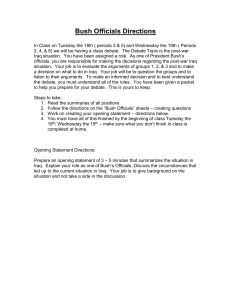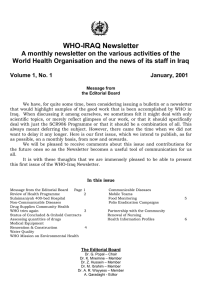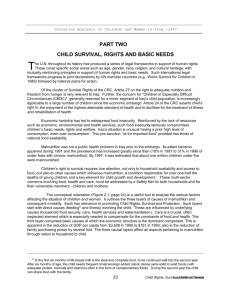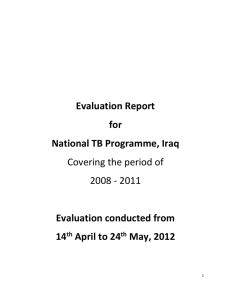Iraq Briefing - World Health Organization
advertisement
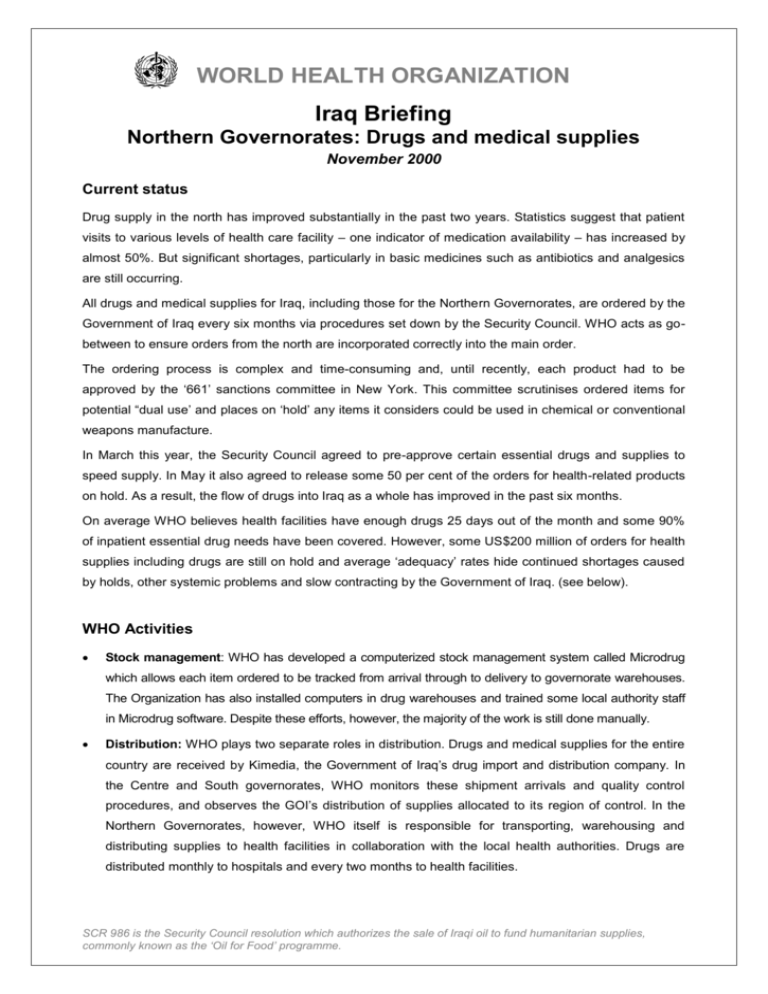
WORLD HEALTH ORGANIZATION Iraq Briefing Northern Governorates: Drugs and medical supplies November 2000 Current status Drug supply in the north has improved substantially in the past two years. Statistics suggest that patient visits to various levels of health care facility – one indicator of medication availability – has increased by almost 50%. But significant shortages, particularly in basic medicines such as antibiotics and analgesics are still occurring. All drugs and medical supplies for Iraq, including those for the Northern Governorates, are ordered by the Government of Iraq every six months via procedures set down by the Security Council. WHO acts as gobetween to ensure orders from the north are incorporated correctly into the main order. The ordering process is complex and time-consuming and, until recently, each product had to be approved by the ‘661’ sanctions committee in New York. This committee scrutinises ordered items for potential “dual use’ and places on ‘hold’ any items it considers could be used in chemical or conventional weapons manufacture. In March this year, the Security Council agreed to pre-approve certain essential drugs and supplies to speed supply. In May it also agreed to release some 50 per cent of the orders for health-related products on hold. As a result, the flow of drugs into Iraq as a whole has improved in the past six months. On average WHO believes health facilities have enough drugs 25 days out of the month and some 90% of inpatient essential drug needs have been covered. However, some US$200 million of orders for health supplies including drugs are still on hold and average ‘adequacy’ rates hide continued shortages caused by holds, other systemic problems and slow contracting by the Government of Iraq. (see below). WHO Activities Stock management: WHO has developed a computerized stock management system called Microdrug which allows each item ordered to be tracked from arrival through to delivery to governorate warehouses. The Organization has also installed computers in drug warehouses and trained some local authority staff in Microdrug software. Despite these efforts, however, the majority of the work is still done manually. Distribution: WHO plays two separate roles in distribution. Drugs and medical supplies for the entire country are received by Kimedia, the Government of Iraq’s drug import and distribution company. In the Centre and South governorates, WHO monitors these shipment arrivals and quality control procedures, and observes the GOI’s distribution of supplies allocated to its region of control. In the Northern Governorates, however, WHO itself is responsible for transporting, warehousing and distributing supplies to health facilities in collaboration with the local health authorities. Drugs are distributed monthly to hospitals and every two months to health facilities. SCR 986 is the Security Council resolution which authorizes the sale of Iraqi oil to fund humanitarian supplies, commonly known as the ‘Oil for Food’ programme. WORLD HEALTH ORGANIZATION Observation: From week to week, nine teams of WHO observers – six in the south and centre and three in the north – track the distribution of randomly chosen items in different therapeutic categories throughout all governorates of Iraq. The aim is to check whether supplies are reaching individual health facilities, in fair proportions and in sufficient quantities. These elements are respectively referred to as ‘equity’, ‘effectiveness’ and ‘adequacy’ . On average WHO observers track around 45 items in 525 facilities throughout the country per month. The observation process also serves to reassure the 661 committee that drugs with potential for dual use are not being diverted but reach their proper destination. Technical advice: WHO is working with health authorities to encourage more accurate methods of assessing needs for medicine and supplies using criteria such as disease burden, outpatient visits, vulnerable groups and shortage reports instead of simple population statistics. Issues: 1. Shortages Total quantities of drugs coming into Iraq have increased in the past four months due arrival of orders, the introduction of the pre-approved list and the release of some holds. But shortages continue to occur particularly in high use, fast moving drugs such as broad spectrum antibiotics, analgesics and antiinflammatory drugs, and also in life-saving drugs and supplies. No blood testing is currently taking place in the largest hospital in the Northern Governorates, Rezgary Hospital in Erbil, due to shortage of hepatitis B antigen, and supplies of items such as paediatric cannula, blood bags, diagnostic reagents are also either unavailable or at critical level. There are many reasons for this situation including: Sanctions procedures: The introduction of a pre-approved list has shortened the process by one cycle, but orders for humanitarian imports still have to pass though a large number of official procedures. Manufacturers also have to get UN permission to supply to Iraq via their country’s diplomatic channels. Slow contracting: The Government of Iraq, whose responsibility it is to create the contracts for drugs supplies for submission to the Office of the Iraq Programme has been very slow in this task. To date no single contract for drugs or supplies have been received by OIP for the current phase. Difficulty in planning accurate orders: Minimal health statistics, largely manual stock and pathology tracking, unpredictable and delayed arrival of items from previous orders, and short planning cycles (six months) all undermine sound planning. For example, by October 2000 none of the $40 million-worth of drugs and medical supplies ordered for the North in the first six months of 2000 (phase 7) had arrived. Only 15% had arrived from phase 6 (July to Dec 1999) and some items were still arriving from phase 1 (Jan-Jun 1997). These delays are caused by factors such as slow passage through the approval system and supplier default, the latter made more common by the fact that standard contracts for SCR 986 supply contain no penalty clauses for late supply or substandard quality. WORLD HEALTH ORGANIZATION Accurate planning also is hindered by limitations of the Micro-drug system which mean WHO staff can only trace whether individual drugs are approved, withheld, contracted, in transit etc, or correlate supplies received with supplies requested, manually. The result is overlapping in ordering, arrivals and distribution. ‘Holds’: Some US$200 million-worth of products are still on hold in the health sector on the basis that they could be used for malign purposes. Among them are medications such as the asthma medication aminophylline, anti-inflammatories such as hydrocortisone, chemicals for essential drug manufacture, laboratory reagents and growth media for diagnosing cholera and salmonella, and some medical equipment containing computer chips. Lack of anticipated local manufacture: Before the imposition of sanctions, state-owned Samara Drug Industries made 60% of essential drugs required in primary health care, particularly antibiotics and analgesics. However holds on raw materials and equipment, plus the need to re-establish quality standards, have prevented Samara from developing activities, and orders of manufactured drugs have not anticipated the resulting gaps in supplies. Quality control: The National Quality Control laboratory lacks the full range of equipment and reagents, which delays the release of drug shipments. Uncoordinated arrivals: Components of multi-drug treatments or essential supplies often do not arrive together. Huge and unrestrained patient demand: There is almost continuous escalation in demand due to a heavy burden of real and anxiety-induced consultations, cultural expectation of prescriptions, and the fact that most diagnosis is based on symptoms rather than investigation. The latter is partly due to tradition and partly because medical laboratories are unable to carry out tests because reagents are not available. Health centre and district hospital doctors estimate up to 70% of patients either do not need a prescription at all, or do not need the number of items prescribed. But they appear helpless to refuse patient demands. Some doctors believe that the problem would be eased by bringing in fees. 2. Drug rationing and antibiotic resistance Almost all primary care health facilities currently ration basic medications such as antibiotics, and analgesics by prescribing only half the recommended course unless the patient returns to say they remain unwell. Since most health centres function more like simple dispensaries and therefore close once their daily quota is exhausted, this reduces access to already poor primary health services. Failure to provide full courses is also likely to be increasing antibiotic resistance. WHO observers say there are shortages in essential drugs but that increasingly the problem is lack of trust that regular supplies will arrive, or lack of confidence or knowledge to prescribe available alternatives. Rationing also distorts assessment of future needs, making it look like stocks are lasting longer than they are. For further information, please contact: Gregory Hartl, Office of the Spokesperson, WHO, Geneva. Telephone: (41 22) 791 2599. Fax: (41 22) 791 4858. Email: hartlg@who.int



